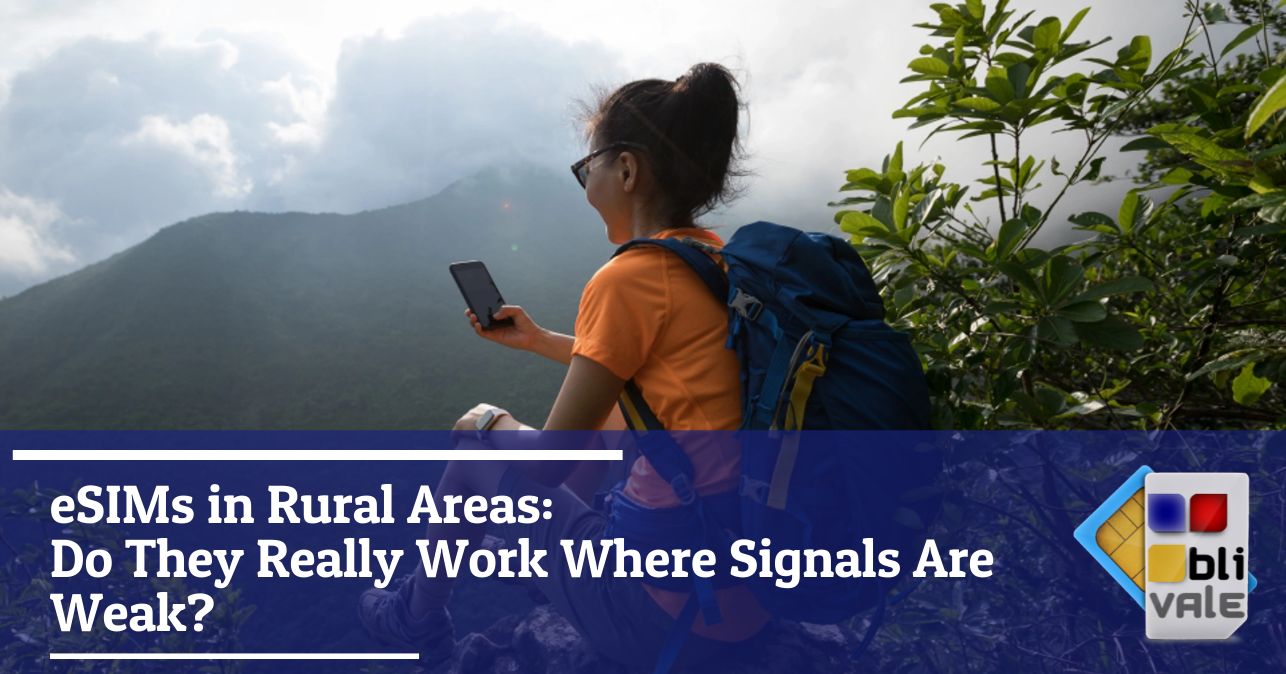How many times have you found yourself in a rural area, surrounded by breathtaking landscapes but completely disconnected from the world ? The frustration of not having coverage just when you need it most is an all-too-common experience for those who love to venture outside of urban centers. With the advent of eSIMs, many are wondering if this new technology could be the solution to the problem of connectivity in remote areas. But is it really the case?
What eSIMs Really Are and How They Work
eSIMs (embedded SIMs) are the digital evolution of traditional physical SIM cards. These are chips integrated directly into devices that can be programmed remotely to connect to any compatible operator. No more small pieces of plastic to insert and remove: everything happens virtually.
But when we move away from cities, does this technological innovation deliver on its promises?
The truth about eSIM coverage in rural areas
The reality is simple but often misunderstood : an eSIM is not magic. Its ability to connect in rural or remote areas depends entirely on the coverage of the operator you are using in that specific area.
In other words, if a mobile operator has not installed antennas or infrastructure in a given rural area, your eSIM will not be able to connect, just like a physical SIM from the same operator would.
The Hidden Benefit of eSIMs for Rural Travelers
Where eSIMs really shine is in the flexibility to quickly switch between carriers . If you find yourself in a remote area where your usual carrier doesn’t have coverage, you can instantly activate a data plan with a local carrier that may have invested more in that specific area.
This ability to “hop” between different operators without having to physically change SIMs can make a difference when traveling in remote regions where coverage varies dramatically from one operator to another.
User Experience with BLIVALE eSIM Unlimited in Various Countries Around the World: Testimonials from Connected Travelers in Rural Areas
"I never thought I'd be able to stay connected while trekking through the Scottish Highlands," says Mark B. from the US, who used BLIVALE's Unlimited eSIM during a trek in the UK (UK). "Even in the most remote villages, I was able to share photos and stay in touch with family, which was impossible with my previous traditional SIM."
Sophie D. from France (FR) had a similar experience during her trip to Japan (JP): "In rural Hokkaido, where many tourists complain about connection problems, my BLIVALE eSIM automatically connected to the operator with the best coverage. I was able to work remotely even from traditional ryokans in the middle of the mountains."
From Australia (AU), James P. confirms the reliability of the service during his travels in South America: "During a hike in the Amazon rainforest in Peru (PE), I was surprised to find signal in places where local guides had assured me I would be completely offline. The eSIM's ability to connect to multiple carriers made all the difference."
"The vast expanses of Namibia (NA) are a real test for any communication technology," explains Helga S. from Germany (DE). "Yet even in the most remote areas of the Namib Desert, the BLIVALE eSIM managed to find a signal in strategic places, allowing me to stay in touch with my family and share this unique experience."
If you are thinking of taking a trip alone or with friends or for work, do not forget the importance of staying connected wherever you are. For unlimited Internet connection, contact BLIVALE where you can get unlimited Internet according to the destinations:
For unlimited plans like data BLIVALE guarantees free roaming anywhere in the world, no additional or hidden costs. Don't let the lack of connection stop you; get ready to explore the world with freedom and spontaneity.
The Device Factor: Not All eSIMs Are Created Equal
An often overlooked factor is that reception capabilities vary significantly between different devices , even when using the same operator via eSIM. Some smartphones and tablets have more powerful antennas or support more frequency bands, which can make a big difference in areas with weak signals.
Before an important trip to remote areas, it is worth checking whether your device is among those with the best reception capabilities.
The Impact of Geography on eSIM Connectivity
Geographic features such as mountains, deep valleys or dense forests can drastically affect signal quality, regardless of whether you use a physical SIM or an eSIM.
In these scenarios, you may need to look for high points or open spaces to get a decent signal. eSIM technology cannot overcome the laws of physics that govern radio wave propagation.
eSIM vs Traditional SIM: A Real-World Coverage Comparison
I have personally tested both technologies in various rural areas of Italy and Europe, and I can confirm that with the same operator, the coverage is practically identical. The difference is not in the SIM technology used, but in the network to which you connect.
This dispels the myth that eSIMs are somehow “superior” or “inferior” to physical SIMs in terms of coverage in remote areas.
When eSIM Becomes Indispensable in Rural Areas
There are scenarios where an eSIM can prove to be a lifesaver in rural areas , especially when:
You have to quickly switch between different carriers to find coverage
You are in border areas where networks from different countries overlap
You need to keep data plans from different operators active at the same time
You are crossing regions with very variable coverage
In these situations, the flexibility of the eSIM far outweighs any small disadvantages it might have.
The Future of Rural Connectivity and the Role of eSIMs
With the expansion of 5G networks and advances in satellite technologies like Starlink, we are seeing a revolution in rural connectivity . eSIMs are perfectly positioned to benefit from these developments, allowing users to easily switch between terrestrial and satellite networks when needed.
In the coming years, we are likely to see hybrid eSIM solutions that automatically combine different connectivity technologies to ensure the best possible experience even in the most remote areas.
Conclusion: eSIM in rural areas, a question of realistic expectations
Ultimately, eSIMs work in rural areas just like traditional SIMs : it all depends on the coverage of the operator you choose. The real revolution is in the flexibility they offer, allowing you to quickly adapt to the network conditions you find.
If you’re planning a trip to remote areas, an eSIM can be a great choice not because it magically improves coverage, but because it gives you more options to stay connected when conditions get tough.
Don’t forget : the best connectivity technology is the one that works where you are. With an eSIM, you’re much more likely to find the right one, even when you venture far from civilization.









